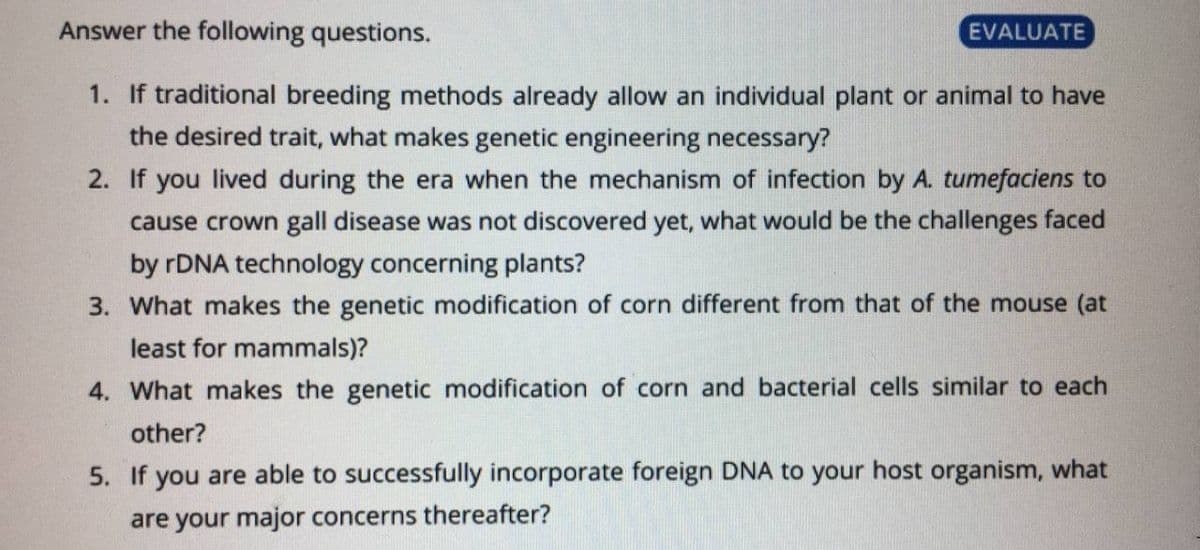Answer the following questions. EVALUATE 1. If traditional breeding methods already allow an individual plant or animal to have the desired trait, what makes genetic engineering necessary? 2. If you lived during the era when the mechanism of infection by A. tumefaciens to cause crown gall disease was not discovered yet, what would be the challenges faced by rDNA technology concerning plants? 3. What makes the genetic modification of corn different from that of the mouse (at least for mammals)? 4. What makes the genetic modification of corn and bacterial cells similar to each other? 5. If you are able to successfully incorporate foreign DNA to your host organism, what are your major concerns thereafter?
Answer the following questions. EVALUATE 1. If traditional breeding methods already allow an individual plant or animal to have the desired trait, what makes genetic engineering necessary? 2. If you lived during the era when the mechanism of infection by A. tumefaciens to cause crown gall disease was not discovered yet, what would be the challenges faced by rDNA technology concerning plants? 3. What makes the genetic modification of corn different from that of the mouse (at least for mammals)? 4. What makes the genetic modification of corn and bacterial cells similar to each other? 5. If you are able to successfully incorporate foreign DNA to your host organism, what are your major concerns thereafter?
Biology: The Dynamic Science (MindTap Course List)
4th Edition
ISBN:9781305389892
Author:Peter J. Russell, Paul E. Hertz, Beverly McMillan
Publisher:Peter J. Russell, Paul E. Hertz, Beverly McMillan
Chapter18: Dna Technologies: Making And Using Genetically Altered Organisms, And Other Applications
Section: Chapter Questions
Problem 13TYK: 13. Suppose a biotechnology company has developed a GMO, a transgenic plant that expresses Bt toxin....
Related questions
Question
Answer the following questions from 1-5

Transcribed Image Text:Answer the following questions.
EVALUATE
1. If traditional breeding methods already allow an individual plant or animal to have
the desired trait, what makes genetic engineering necessary?
2. If you lived during the era when the mechanism of infection by A. tumefaciens to
cause crown gall disease was not discovered yet, what would be the challenges faced
by rDNA technology concerning plants?
3. What makes the genetic modification of corn different from that of the mouse (at
least for mammals)?
4. What makes the genetic modification of corn and bacterial cells similar to each
other?
5. If you are able to successfully incorporate foreign DNA to your host organism, what
are your major concerns thereafter?
Expert Solution
This question has been solved!
Explore an expertly crafted, step-by-step solution for a thorough understanding of key concepts.
Step by step
Solved in 3 steps

Knowledge Booster
Learn more about
Need a deep-dive on the concept behind this application? Look no further. Learn more about this topic, biology and related others by exploring similar questions and additional content below.Recommended textbooks for you

Biology: The Dynamic Science (MindTap Course List)
Biology
ISBN:
9781305389892
Author:
Peter J. Russell, Paul E. Hertz, Beverly McMillan
Publisher:
Cengage Learning

Biology: The Dynamic Science (MindTap Course List)
Biology
ISBN:
9781305389892
Author:
Peter J. Russell, Paul E. Hertz, Beverly McMillan
Publisher:
Cengage Learning